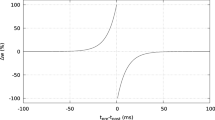Abstract.
The long-term potentiation (LTP) or long-term depression (LTD) of synaptic strength are currently considered to be the first microscopic steps leading to learning and memory. The great majority of experiments (both in vitro and in vivo) studying the basic mechanisms of LTP and LTD induction use conditioning protocols in which the presynaptic stimuli are delivered at constant frequencies. This is not, however, what is commonly found in vivo, where a highly irregular spiking activity seems to drive most of the neuronal functions. Thus, some important aspects of the induction characteristics of LTP and LTD expressed in vivo might have been overlooked by the experiments. Using a simple schematic model for a synapse we show here that, in fact, the statistical properties of a presynaptic conditioning signal could change the probability to induce LTP and/or LTD, suggesting a new and faster operating mode for a synapse.
Similar content being viewed by others
Author information
Authors and Affiliations
Additional information
Received: 3 September 1998 / Accepted in revised form: 14 April 1999
Rights and permissions
About this article
Cite this article
Migliore, M., Lansky, P. Computational model of the effects of stochastic conditioning on the induction of long-term potentiation and depression. Biol Cybern 81, 291–298 (1999). https://doi.org/10.1007/s004220050563
Issue Date:
DOI: https://doi.org/10.1007/s004220050563




